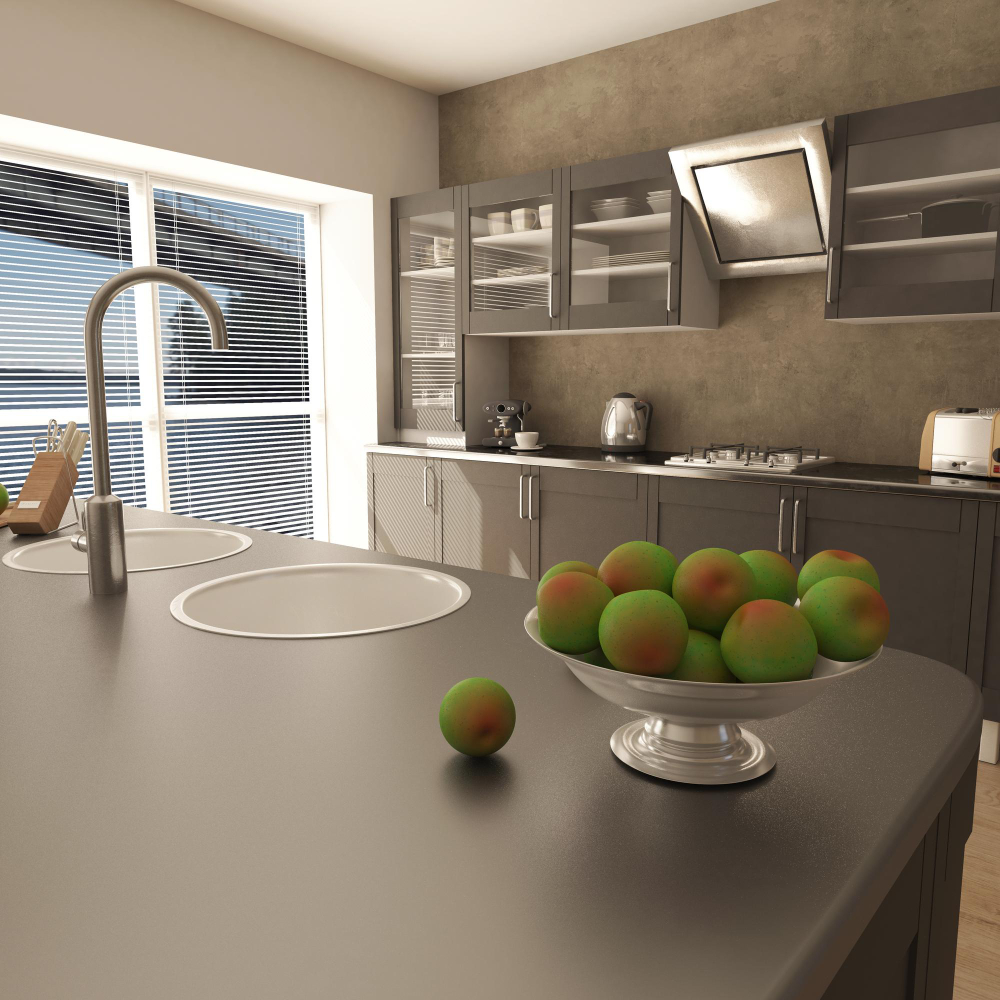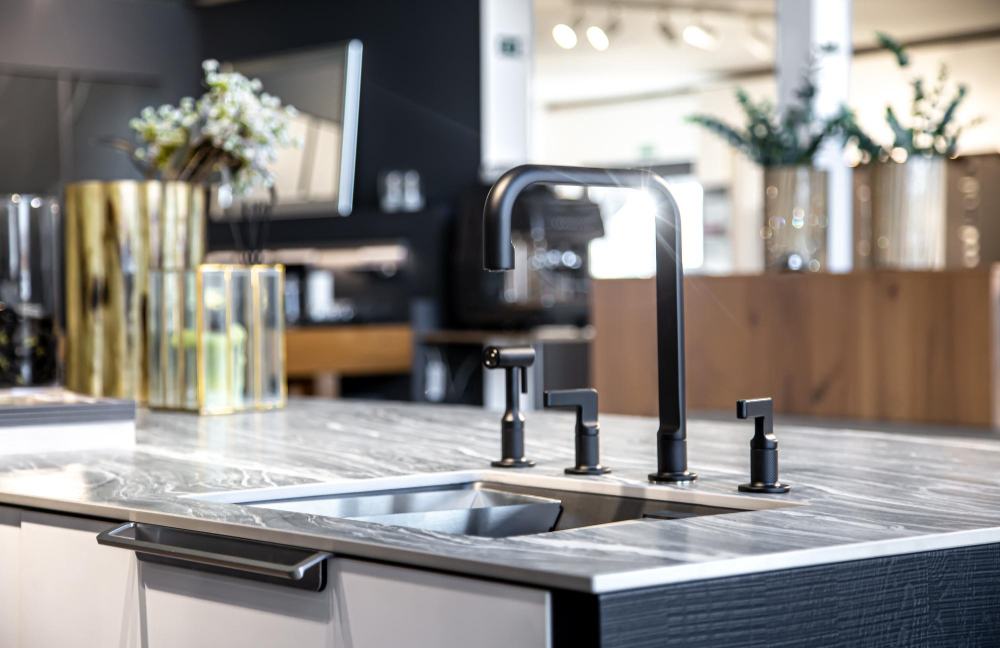Many kitchen worktops do not fit exactly to length, necessitating an assembly process to connect two pieces together. This is often true with laminate and wooden surfaces.
Mark where you need to cut using masking tape affixed along the edge of the wall before using a jigsaw to cut away excess sections.

Create a straight edge.
Most laminate and wooden worktops, whether laminate or wooden, come equipped with support bars at the front and brackets at the back for fastening to kitchen cabinets. To prevent your worktops from slipping during installation, it’s advisable to position these supports beforehand to avoid squeaking and potential damage. Using their holes as anchor points, you can then screw laminate worktops onto each support using the screws provided with each. Once laid, you should cut strips that coordinate with it for covering rough edges; these strips should then be adhered using glue for faster adhesion.
Most installations will require you to join two worktops at some point during installation, either to form a corner or join them into a straight run of worktops. It is preferable that this joint be replaced into a location away from any sources of heat (like hobs or cookers) where hot splatters might collect; as well as any sinks or other apertures where water could pool and cause leakage.
For an accurate and tidy worktop join, first create a straight edge on both worktops being joined. Clamp a length of timber against each worktop before using a router fitted with a straight-cutting bit to cut along this line, giving a smooth and precise edge that’s much simpler to work with than sawn wood pieces.
Alternative solutions, such as using metal strips, may give the desired result; however, this method often doesn’t look as appealing and tends to collect dirt underneath. If this option is chosen, however, a cutting jig must be used in order to correctly profile both ends of your worktop and create tie bolt pockets; full instructions are included with your cutting jig purchase.
Once you’ve achieved an even and straight join on both worktops, test for fit by placing one against the other and standing them together. If they fit properly, apply sealant along the worktop join before fastening it securely with long countersunk wood screws measuring 16mm long by 3.5mm wide.
Create a joining cut.
Joining kitchen worktops at your home involves various methods. Some may be more suitable depending on the material of the worktop; laminate worktops may benefit from using a mason’s mitre joint, while wooden ones might prefer dovetail joins; the choice depends on both its type and your personal preference.
Before beginning, carefully measure both worktops to identify where they will meet. Mark these points using a circular saw or jigsaw before cutting the worktops down to size with either a circular saw or jigsaw. Be sure to leave enough space between their joints for easy positioning when finished; this way, your final results should look just right when assembled together!
Once the cutting process is complete, use sandpaper to smooth any rough edges on both worktops. Also drill any necessary holes for sinks or hobs, as well as cut out areas where appliances will be fitted; this will help prevent water or oil splashing, causing damage to joins between worktops.
To connect the worktops together, joining bolts must be used. These are available from most DIY or builder merchants and require using a hole saw to drill for bolt holes before inserting and tightening bolts with tie bolts as the final step in connecting them together.
When joining kitchen worktops, it is essential to take your time and follow all instructions provided by the manufacturer. Be sure to create an attractive yet strong bond that can last many years. Also, try not to place joints too close to appliances such as cookers and sinks, as this could place unnecessary strain on joints.
Dovetail joints offer a more elegant finish for joins than Mason’s mitre joints, though they require more skill and precision than the former option. When used correctly, they produce an impressive, professional-looking result. However, dovetail joins are only suitable for solid wood worktops; dovetailing requires using a Trend worktop jig and router, beyond most basic DIYers capabilities.
Insert Bolts
Assuming you aren’t installing an integrated sink or hob with their own flanges, most often you will be joining worktops to existing cabinets. In such instances, simply screw in the fixing brackets included with your worktops; be sure to tighten each of them gently until all have been connected securely before finishing off.
If you are joining two worktops at 90 degrees, a male and female masons mitre must be cut using a special jig and router. If unsure, contact your worktop manufacturer, who should provide instructions and a jig to assist in this task.
To ensure a strong and clean join, an aluminium joining strip can be the solution to creating an aesthetic yet strong connection between worktops and cabinets. When installing it, make sure it is aligned and marked for the correct fixing positions before marking and drilling 2mm-diameter by 20 mm-deep holes to accommodate fasteners. Apply silicone sealant along its joined edge before screwing it into place while being careful not to overtighten, clearing away any overspill sealant when necessary.
Tie bolt fasteners, available from most DIY stores and builders merchants, provide another method for joining mitred worktops together. These fasteners consist of a bolt with two flat, wide washers that slide over its end for securement. You can then use either PVA or silicone sealant or even some draft-proof caulking to help prevent water penetration through joints.
Use of a router can help create more attractive and seamless joints with some practice and skill, although it isn’t suitable for beginners as it requires specialisation of tools. However, if you have enough woodworking experience, then this technique should not pose too many difficulties.
Apply Sealant
Sealant application will complete your new kitchen worktops’ watertightness. Typically, manufacturers will specify which adhesive or silicone mastic product to use; generally, PVA adhesive or silicone mastic is preferred. Apply sealant along both end strips and between worktop gaps using wide masking tape if applicable to prevent accidentally applying too much sealant in some places.
Once your worktop has been cut to size, it is wise to perform a final test fit with its back edge against the wall. This will allow you to ensure it has a suitable length gap and that it sits flush against the wall. Ideal settings should allow at least a couple inches more than its size for movement without creating leaks or issues with leakage.
Check that the edges of your worktop are finished properly; any mistakes here could prove difficult to rectify later, leading to unsightly joins that do not secure properly. If you feel insecure about finishing these edges yourself, consider hiring a professional to complete this step for you.
Prefabricated worktops typically come equipped with strips of laminate that can be used to conceal any rough edges on the worksurface, creating the appearance that it was professionally installed while remaining easy. If you can’t find matching laminate pieces, simply sand down any rough edges before using a caulking gun to apply some coloured sealant and use another caulking gun to apply more of it later; once dry, sand the joint again to create a smooth surface. This step isn’t essential but will ensure your worktops look as professional as possible!

Horace is a health and wellness researcher with expertise in holistic medicine and evidence-based treatments. His writing covers everything from nutrition and fitness to emerging healthcare technologies.

